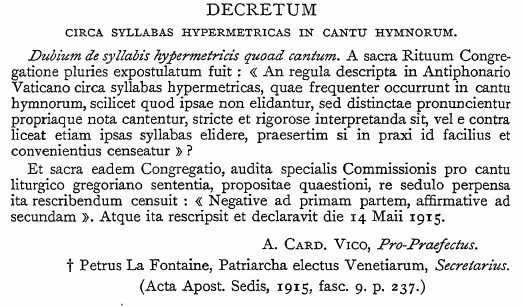I’m sure most dioceses celebrate the jubilee years of ordained and consecrated priests, sisters and brothers with a designated liturgy. Our diocese held such an observance (Vespers) this week, held at our mother parish. Our Office of Worship thankfully asks for simple ministry, aka “moi,” to lead the congregational singing. And a unique congregation it is, every year. I was likely the sole member of the laity present among 150 congregants.
I’ll recap what was prayed in song in this piece and offer some interesting (to me) reflections. This year I did not choose any of the repertoire.
After the invocation, the hymn of the evening was “For the fruits of this creation” (Ar hyd y nos.) The gathered priests, deacons, sisters and brothers took up the singing with full throat and full measure. It is always so edifying every time religious take up the role of the “assembled” so heartily.
The first two psalms were canted using Meinrad tones. This was my first encounter with these pervasively known settings. These were sung well, but as could be expected, psalm tone settings of any stripe aren’t everyone’s cup of tea, so as we sang in alternatim, the volume of singing was halved by comparison to the hymn. As a composer/arranger, my initial assessment of the two Meinrad tones that were sung was sort of “ho-hum.” I wouldn’t say via such limited exposure that they seem hackneyed, but like so much of what is employed in the last century, they don’t ascend much higher than the meanest of utilitarian purpose. For one thing, the settings I led were hopelessly diatonic, and didn’t seem to exhibit a schematic coherence evident in diatonic constructs as simple as “Heart and Soul.” I wouldn’t blanch calling them pastiche. That said, the pastor who did choose the settings mentioned that Meinrad tones were by far the most commonly employed in seminary formation over the last three decades. To me, there was a paucity of intuitive logic to these two tones by comparison to “Gregorian” tones that I’m more comfortable using. Perhaps that is because those tones are modal, and modes are, if nothing else, bound to tetrachord sensibilities. So, to sum up this aspect, it seems that the use of tones, whether Meinrad, Gelineau or Rossini’s et al, becomes an effort of selective and synthetic cultivation, not necessarily tied to predecessor forms. To illustrate what I mean by that, if the only music one hears in a long-lived, developmental period of time is muzak as found in elevators, stores, waiting rooms and supermarkets, that person will have no other foundation to appreciate any other more worthy and significant types of music. (Suffice it to say, we owe a debt to folks like Adam Bartlett, Paul Ford and many other noted seminary professors who’ve taught the basics of “Gregoriana” to their charges.)
After the responsory my duties were over. After “Deo gratias” I more or less hi-jacked the dismissal by intoning the simple “Salve Regina.” Once again, the gathered took the roof of our large church off with their purposeful chanting.
I’ve thought of this paradox before, but it was never so apparent to me as this vespers: why is it that clergy and religious have the chutzpah to chant psalmody (even via less worthy means), hymnody and plainsong when they’re sequestered together, and then basically eschew those forms when they return to their parishes as pastors and vicars? We all know that strong leadership, whether amateur or professional, generally ensures solid performance practice among choirs/ensembles/scholas that “lead” and aid congregational singing in regular worship. But there seems an inordinate interest on the part of many pastors to mistake the accessibility of the modern song forms as being tantamount with their concept of full, active, conscious participation. Whether one has participated in a CMAA colloquium or intensive seminar or not, most folks know that the “actuosa” concept of FCAP is just as accessible to everyone through hymns, chants and psalmody as are sacropop and contemporary praise and worship styles, and likely more affective to the soul. So, again, why do I sense there’s sort of double-standard at play when clergy worships together with our native forms, but then these great forms are left orphaned when they return to their home parishes?


